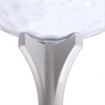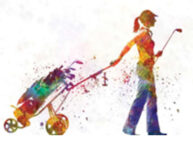The Golf Tee – A Little History…
 Every golfer I know uses a golf tee to drive the ball off the tee box. It’s not a rule, and not required that you use a tee, but golfers, especially those with today’s oversized drivers need to have the ball sit up above the ground in order to hit the “sweet spot” on the club face.
Every golfer I know uses a golf tee to drive the ball off the tee box. It’s not a rule, and not required that you use a tee, but golfers, especially those with today’s oversized drivers need to have the ball sit up above the ground in order to hit the “sweet spot” on the club face.
Back in the early days of golf, the “tee,” as we know it today, consisted of a tiny mound of sand. It served to elevate the ball. But it was a messy business and by the time of the late 1800’s, several different patents for golf tees made of rubber, metal or wood were registered. It was not until the 1920s that today’s modern tee, invented by a New Jersey dentist, William Lowell, became popular. Made of a one-piece wooden peg that could be easily inserted into the ground, the “Reddy Tee” was promoted by the great golfer Walter Hagen, for use by both amateur and professional golfers. (If you are interested in more history about the origins of the golf tee, you might find this book interesting: Golf: An Unofficial and Unauthorized History of the World’s Most Preposterous Sport
Enough of history. What about the golf tee you choose to use when you play today?
- What is it made of?
- How long is it?
- Is one style better for your game than another?
- Does it make a difference?
Today golf tees are available in a variety of materials and styles. Wooden tees are still the least expensive traditional tee, but are easily broken. (Some golfers consider breaking your tee a good sign.) There are plastic tees which are more durable but are made in the traditional “Reddy Tee” shape, and a Zero Friction Tee with a three-prong design (see photo left.) The manufacturer claims it provides the golfer with the longest and most accurate golf shot. They are more expensive (about 10¢ each) but they are nearly indestructible. There are also “environmentally friendly” tees that are biodegradable. These are made of either Eco Friendly Bamboo or a Birch Head with a “no waste” veneered shank. As all wooden tees finally rot in the ground I don’t see the point of spending the extra $$$ on “Eco-Friendly” tees. In fact, buying indestructible plastic tees would probably be more “Eco-Friendly.” – Just my opinion.
Another alternative is something called the Brush-T Reusable Golf Tee. It uses fixed toothbrush-like bristles to support the ball. It’s design is (according to the manufacturer) supposed to increase your distance and accuracy. I’ve tried the Brush-T and don’t like it. But there are players I know who swear by it and won’t use any other tee.
 And then there is the Step Down Tee which has a fixed length so that when you place it in the ground the distance below the ball is always consistent. The larger tees are used with the driver, the smaller tees are used with the woods and irons.
And then there is the Step Down Tee which has a fixed length so that when you place it in the ground the distance below the ball is always consistent. The larger tees are used with the driver, the smaller tees are used with the woods and irons.
Which golf tee should you use? I think it comes down to whatever style of tee works best for you. The most important consideration is how well do you hit the ball off the tee? Does the material or shape make a difference to your game? Test a few and make a choice. If you can get yourself to a practice range where you can use tees on grass rather than on those rubber matts, bring a variety of tee styles with you. Hit 5 balls off of each using the same club. See if one tee actually improves your distance and accuracy.
Which tee do you use? Does it make a difference to your game?






